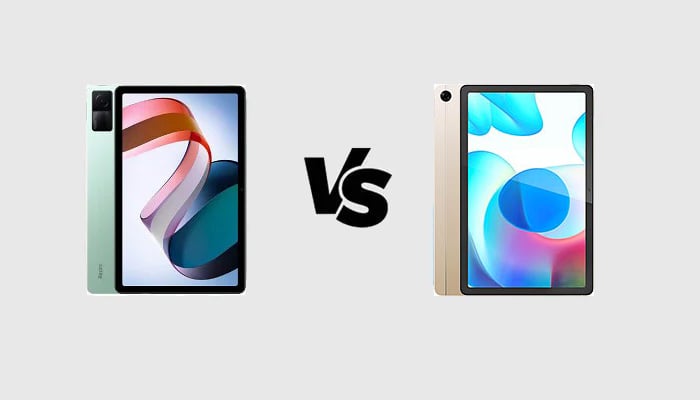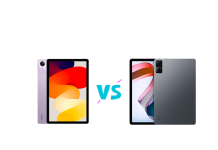Finally, even Redmi has a tablet. Just like all of its phones, it is an affordable tablet, and this is its biggest advantage. It brings a powerful chipset and a big battery to the market at a very affordable price. But Redmi is not the only sub-brand that brought a tablet to the market: its direct rival is Realme, which came up with the Realme Pad. Another very affordable tablet that was released more than a year before, but still very actual. A lot of people are actually wondering whether they should go for the amazing street prices of the Realme tablet or they should get something launched more recently such as the Redmi one. Here is a comparison between the main specifications of the Redmi Pad and the Realme Pad which will help you to find it out.

Redmi Pad vs Realme Pad
| Xiaomi Redmi Pad | Realme Pad | |
|---|---|---|
| DIMENSIONS AND WEIGHT | 250.5 x 158.1 x 7.1 mm, 465 grams | 246.1 x 155.9 x 6.9 mm, 440 g |
| DISPLAY | 10.61 inches, 1200 x 2000p (Full HD+), IPS LCD | 10.4 inches, 1200 x 2000p (Full HD+), IPS LCD |
| PROCESSOR | MediaTek Helio G99, octa-core 2.2 GHz | Mediatek Helio G80, octa-core 2 GHz |
| MEMORY | 3 GB RAM, 64 GB – 4 GB RAM, 128 GB – 6 GB RAM, 128 GB – micro SD slot | 3 GB RAM, 32 GB – 4 GB RAM, 64 GB – 6 GB RAM, 128 GB – micro SD slot |
| SOFTWARE | Android 12, MIUI | Android 11, Realme UI |
| CONNECTIVITY | Wi-Fi 802.11 a/b/g/n/ac, Bluetooth 5.2, GPS | Wi-Fi 802.11 a/b/g/n/ac, Bluetooth 5.0, GPS |
| CAMERA | Single 8 MP f/2.0 8 MP f/2.3 front camera |
Single 8 MP 8 MP front camera |
| BATTERY | 8000 mAh, fast charging 18W | 7100 mAh, fast charging 18W |
| ADDITIONAL FEATURES | Ultrawide front camera | Optional LTE connectivity |
Design
The most beautiful tablet of the duo is the Realme Pad. First of all, it is entirely built with a premium material as it comes with an aluminum frame and aluminum back. It is very thin and even pretty lightweight. Further, it does not have a big camera module but just a single camera placed directly on the rear cover, so it provides a very minimalistic look. Last but not least, it is more compact because it packs a smaller display and a smaller battery. The Redmi Pad is built with a plastic back and an aluminum frame, it is bigger and chunkier than its rival. Further, it has a big camera module, not the best for design lovers. Both tablets come with a pretty high screen to body ratio, the bezels around the displays are very narrow and the screen covers more than 80 percent of the front panel.
Display
Are you looking for the most advanced display overall? If so, you should opt for the Redmi Pad without thinking twice. First of all, with a diagonal of 10.61 inches, it has a wider display than its opponent. Further, it is able to show up to one billion colors with a Full HD+ resolution of 1200 x 2000 pixels; last but not least, it has a 90 Hz refresh rate, great for gaming and for those who want a smoother viewing experience. The Realme Pad has a 10.4-inch panel with a 10.4-inch diagonal showing the images with a Full HD+ resolution of 1200 x 2000 pixels. Unfortunately, both handsets feature IPS LCD panels, so do not expect those deep blacks and brilliant colors you can get with OLED displays. But they both come with four stereo speakers, so the audio experience is good.
Specs & Software
The most powerful hardware setup belongs to the Redmi Pad. It is powered by the new MediaTek Helio G99 chipset built with a 6 nm production process and with an octa-core architecture composed of two Cortex A76 CPUs running at a max frequency of 2.2 GHz, six Cortex A55 CPUs running at 2 GHz, and a Mali G57 MC2 GPU. Alongside the chipset, there are up to 6 GB of RAM and up to 128 GB of UFS 2.2 native storage. With the Realme Pad, you get an inferior MediaTek Helio G80 mobile platform paired with up to 6 GB of RAM and up to 128 GB of native storage. Besides having a better hardware, the Redmi Pad ships with Android 12 out of the box, while the Realme Pad is still based on Android 11.
Camera
There are no big differences between these two tablets when it comes to the cameras, as their sensors are the same. They come with an 8 MP rear camera and an 8 MP ultrawide front camera sporting a FOV of 105 degrees. The photo quality is more or less the same and they are able to record videos with a 1080p resolution at 30 fps.
Battery
The Redmi Pad is equipped with a big battery and it is able to provide a longer battery life with every usage. Given its bigger dimensions, it was easier for Xiaomi to include a bigger battery. The Realme Pad has a smaller battery but it supports reverse charging allowing you to use it as a power bank.
Price
The starting price of the Redmi Pad in the Chinese market roughly translates into €250 or $250 at the actual change, while you can easily find the Realme Pad for less than €160 or $160. The Redmi tablet wins the comparison, but its price is way higher.
Xiaomi Redmi Pad vs Realme Pad: PRO and CONS
Xiaomi Redmi Pad
PRO
- Bigger battery
- Wider display
- Android 12 out of the box
- Better chipset
CONS
- Limited availability
Realme Pad
PRO
- Worldwide availability
- More compact
- Optional LTE connectivity
- Reverse charging
CONS
- Inferior chipset
- Smaller battery
RELATED







